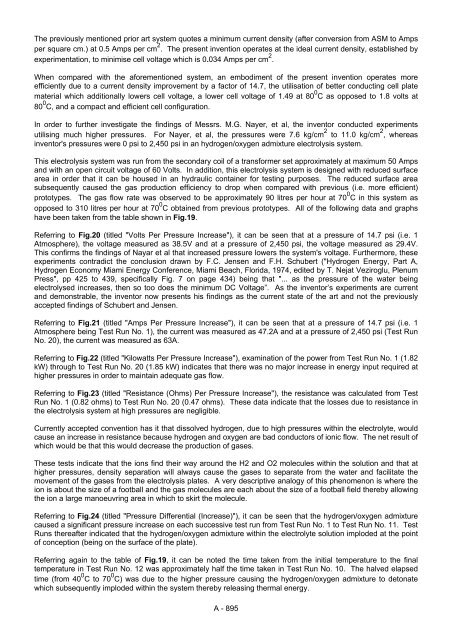A Practical Guide to 'Free-Energy' Devices
A Practical Guide to 'Free-Energy' Devices
A Practical Guide to 'Free-Energy' Devices
Create successful ePaper yourself
Turn your PDF publications into a flip-book with our unique Google optimized e-Paper software.
The previously mentioned prior art system quotes a minimum current density (after conversion from ASM <strong>to</strong> Amps<br />
per square cm.) at 0.5 Amps per cm 2 . The present invention operates at the ideal current density, established by<br />
experimentation, <strong>to</strong> minimise cell voltage which is 0.034 Amps per cm 2 .<br />
When compared with the aforementioned system, an embodiment of the present invention operates more<br />
efficiently due <strong>to</strong> a current density improvement by a fac<strong>to</strong>r of 14.7, the utilisation of better conducting cell plate<br />
material which additionally lowers cell voltage, a lower cell voltage of 1.49 at 80 0 C as opposed <strong>to</strong> 1.8 volts at<br />
80 0 C, and a compact and efficient cell configuration.<br />
In order <strong>to</strong> further investigate the findings of Messrs. M.G. Nayer, et al, the inven<strong>to</strong>r conducted experiments<br />
utilising much higher pressures. For Nayer, et al, the pressures were 7.6 kg/cm 2 <strong>to</strong> 11.0 kg/cm 2 , whereas<br />
inven<strong>to</strong>r's pressures were 0 psi <strong>to</strong> 2,450 psi in an hydrogen/oxygen admixture electrolysis system.<br />
This electrolysis system was run from the secondary coil of a transformer set approximately at maximum 50 Amps<br />
and with an open circuit voltage of 60 Volts. In addition, this electrolysis system is designed with reduced surface<br />
area in order that it can be housed in an hydraulic container for testing purposes. The reduced surface area<br />
subsequently caused the gas production efficiency <strong>to</strong> drop when compared with previous (i.e. more efficient)<br />
pro<strong>to</strong>types. The gas flow rate was observed <strong>to</strong> be approximately 90 litres per hour at 70 0 C in this system as<br />
opposed <strong>to</strong> 310 litres per hour at 70 0 C obtained from previous pro<strong>to</strong>types. All of the following data and graphs<br />
have been taken from the table shown in Fig.19.<br />
Referring <strong>to</strong> Fig.20 (titled "Volts Per Pressure Increase"), it can be seen that at a pressure of 14.7 psi (i.e. 1<br />
Atmosphere), the voltage measured as 38.5V and at a pressure of 2,450 psi, the voltage measured as 29.4V.<br />
This confirms the findings of Nayar et al that increased pressure lowers the system's voltage. Furthermore, these<br />
experiments contradict the conclusion drawn by F.C. Jensen and F.H. Schubert ("Hydrogen Energy, Part A,<br />
Hydrogen Economy Miami Energy Conference, Miami Beach, Florida, 1974, edited by T. Nejat Veziroglu, Plenum<br />
Press", pp 425 <strong>to</strong> 439, specifically Fig. 7 on page 434) being that "... as the pressure of the water being<br />
electrolysed increases, then so <strong>to</strong>o does the minimum DC Voltage”. As the inven<strong>to</strong>r’s experiments are current<br />
and demonstrable, the inven<strong>to</strong>r now presents his findings as the current state of the art and not the previously<br />
accepted findings of Schubert and Jensen.<br />
Referring <strong>to</strong> Fig.21 (titled "Amps Per Pressure Increase"), it can be seen that at a pressure of 14.7 psi (i.e. 1<br />
Atmosphere being Test Run No. 1), the current was measured as 47.2A and at a pressure of 2,450 psi (Test Run<br />
No. 20), the current was measured as 63A.<br />
Referring <strong>to</strong> Fig.22 (titled "Kilowatts Per Pressure Increase"), examination of the power from Test Run No. 1 (1.82<br />
kW) through <strong>to</strong> Test Run No. 20 (1.85 kW) indicates that there was no major increase in energy input required at<br />
higher pressures in order <strong>to</strong> maintain adequate gas flow.<br />
Referring <strong>to</strong> Fig.23 (titled "Resistance (Ohms) Per Pressure Increase"), the resistance was calculated from Test<br />
Run No. 1 (0.82 ohms) <strong>to</strong> Test Run No. 20 (0.47 ohms). These data indicate that the losses due <strong>to</strong> resistance in<br />
the electrolysis system at high pressures are negligible.<br />
Currently accepted convention has it that dissolved hydrogen, due <strong>to</strong> high pressures within the electrolyte, would<br />
cause an increase in resistance because hydrogen and oxygen are bad conduc<strong>to</strong>rs of ionic flow. The net result of<br />
which would be that this would decrease the production of gases.<br />
These tests indicate that the ions find their way around the H2 and O2 molecules within the solution and that at<br />
higher pressures, density separation will always cause the gases <strong>to</strong> separate from the water and facilitate the<br />
movement of the gases from the electrolysis plates. A very descriptive analogy of this phenomenon is where the<br />
ion is about the size of a football and the gas molecules are each about the size of a football field thereby allowing<br />
the ion a large manoeuvring area in which <strong>to</strong> skirt the molecule.<br />
Referring <strong>to</strong> Fig.24 (titled "Pressure Differential (Increase)"), it can be seen that the hydrogen/oxygen admixture<br />
caused a significant pressure increase on each successive test run from Test Run No. 1 <strong>to</strong> Test Run No. 11. Test<br />
Runs thereafter indicated that the hydrogen/oxygen admixture within the electrolyte solution imploded at the point<br />
of conception (being on the surface of the plate).<br />
Referring again <strong>to</strong> the table of Fig.19, it can be noted the time taken from the initial temperature <strong>to</strong> the final<br />
temperature in Test Run No. 12 was approximately half the time taken in Test Run No. 10. The halved elapsed<br />
time (from 40 0 C <strong>to</strong> 70 0 C) was due <strong>to</strong> the higher pressure causing the hydrogen/oxygen admixture <strong>to</strong> de<strong>to</strong>nate<br />
which subsequently imploded within the system thereby releasing thermal energy.<br />
A - 895

















